Introduction
Electronic resources are no more alien in this era of globalization. Information and knowledge provided in electronic resources are vital and play important elements for survival in information and knowledge society. Information and knowledge society is to create, distribute, use, integrate and manipulate the information that is significant to the economic activities. Library plays crucial function in positioning and delivering the information and knowledge to the society. Since library acts as a repository, it serves users with processed information and disseminate to the right users who acquire them. In achieving the vision of 2020, Malaysians are moving forward to become a knowledge-based society with high skilled economy where intellectual capital, creativity and innovation act as prime drivers for the economic growth. Adequacy of collections (such as books, journals, magazines) is an important factor that fulfills the needs of user demand especially to support their academic or research activities.
The National Library of Malaysia (NLM) takes the initiative to give the best services by providing the latest and advance technology to community. The technology behind is the Information Communication and Technology (ICT) where it becomes one of the challenges to NLM in giving the services at par with community’s expectation. Embroiled with ICT, electronic resources are the main focus to users to access their information of interest. This medium indeed makes them easier and faster to reach out the information as compared to printed materials. The growing demand on the electronic resources has led NLM to accommodate the latest information to fulfill the users’ requirements. The accessibility to the electronic resources is equipped with the latest technology infrastructure such as the latest hardware and software, Internet with high-speed broadband connection and learning space with conducive environment. These are among the factors that will necessitate users’ experience in using the library services. Little work had been published on the user satisfaction at the library. The library’s main function is as a service provider to the academic community where in order to provide the best service, the library should have a periodic assessment where they can evaluate and improve the service to meet user’s expectations. Hence this study is conducted to examine the user satisfaction with electronic resources accessed in the university’s library.
The rest of this paper is organized as follows. The following section reviews the past works on electronic resources, focusing on its concepts and theories, as well as the model or framework used. The third section describes the study framework and the research method by giving the details on measurement, population, sampling and data collection approach. The ensuing section provides the study findings and the final section concludes this paper.
Literature Review
The rapid growth of information, communication and technology (ICT), libraries have challenges in holding information resources in traditional and electronic forms to the users. According to Lee and Boyle (2004) an electronic resource is defined as a product and service in digital form that is being marketed. Electronic resources are the product that delivers data in text, numerical, graphical as a commercial product available in digital form includes full text databases, electronic journals, image collections and multimedia products. The electronic information becomes a significant resource to the people to get the information. The statistic of the usage of the electronic resources has become a hot issue in the field in the library (Wu, 2006).
The electronic resources were influenced by the information literacy and skill in accessing the information of the users. However, there exists several factors affecting the use of electronic resources such as limitation of users’ access to the electronic resources, lack of awareness of the resources and slow Internet speed. A low level of skillfulness to search data and information to retrieve good information affected the utilization of electronic resources. The issues and problems encountered by the respondents in accessing electronic resources are a large number of irrelevant information, download delay, failure to find information, inadequate or lack of search skills, high cost of access and difficulties in navigating through electronic resources (Kinengyere, George and Bernard, 2012).
According to Tyler and Hastings’ (2011) study, the growth of online learning and information technology has resulted in more access to digital resources than printed resources. Online learning library support for virtual patrons has evolved into the digital or virtual component of the library. The use of electronic resources determines the use of electronic resources, users’ skills in handling electronic resources, and the purpose of their use. An electronic resource helps the users to access the information timely and manage the information effectively and efficient retrieval and meeting information needs. The electronic resources are seen to be good substitutes for conventional resources, if the access speed is fast, and more computer terminals are installed to provide access to electronic resources. The librarians have to reallocate more budgets to expand the availability of electronic resources for students and faculty. Furthermore, library professionals should help users to know what high-quality free resources are available on the Internet and how to search these resources more effectively and efficiently. The librarians need to focus more on opportunities for providing training programs for academics on the use of online databases, use of electronic resources and information skills.
Research Methodology
This section presents the proposed study framework and methodology used. The proposed framework consists of four independent variables and one dependent variable, as displayed in Figure 1. These variables have been identified from the theoretical review and previous works.
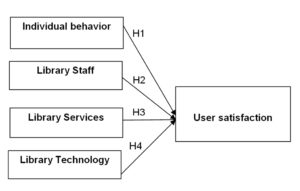
Figure 1: Theoretical framework proposed for the study
The description of each variable used in the study model is given as follows:
User satisfaction using library electronic resources
User satisfaction is to measure how the services supplied by a library meet or surpass users’ expectations. They focus on the importance of fulfilling users’ expectations. According to O’Brien and Toms (2010) user satisfaction is one method of evaluating the effectiveness of library services. Users’ feedback help the library to improve services and changes in the service to make it easier to use, more welcoming, or otherwise enhance the user’s experience. User satisfaction depends to a large extent on the ability of the library to integrate user needs into the development of the library. Users’ satisfaction helps the library to measure the overall quality of the service experiences and improve the services based on the satisfaction feedback from the users.
Individual behavior
According to Wilson (2000), information behavior is the totality of human behavior in relation to channels and sources of seeking and use of information. Information use behavior consists of the physical and mental acts involved in incorporating the information found into the person’s existing knowledgebase. In this process of information seeking behavior, it involves the act of comparing, analyzing and evaluating the existing and new information. In the study from Nadzir and Salim (2013) they mentioned that the person who has the knowledge on information seeking behavior has an advantage in finding information to support their study or research process. Information seeking behavior arises as a consequence of a need to accomplish the desired tasks where the success or failure of doing so would likely to influence their satisfaction. The improvement of the information literacy will guide them to the right techniques to search the information (Shen, 2010). As claimed by Mohd Nazir, Abd Wahab and Othman (2015), in order to satisfy the information seeking activities, one should possess information literacy skills.
Library staff
The library should have professional staff to handle the information and knowledge. The librarian must have the qualification to manage the library and its services. The librarian who is positive, proactive, highly motivated and assertive is likely to foster productive relationships with other staff and give them confidence in his or her ability (Steve, 1996). Librarians must have a qualification in library management and experience to handle the library activities (Skretas, 2005). Library staff must be pro-active and aggressive to assist and accommodate the user to solve the searching problems. Mamtora (2013) explained that the primary role of the librarian is to provide support information delivery services. In order to meet the user’s requirements, the librarian should have skill and familiarize themselves with various stages of research life cycle and information activities.
Library services
The library provides services to the users to search and obtain the information available to users in the library. The library services such as reference collections, borrowing and returning, electronic resources, free Internet access, audiovisual services and others. According to Collison (1952), the information services are the library capabilities to provide the vast amount of material contained in the circulation departments and their reserve stocks to meet users’ need. According to Skretas (2005), all the equipment and similar technical infrastructure that support the library functions should be appropriate and well function. These included telecommunications and computer networks with appropriate technical support for regular and unexpected conditions to protect library information services. The library should have conducive environment of space, heating or cooling, lighting to attract user entry and provide comfortable environment for library personnel.
Library technology
Technology is the collection of tools, including machinery, modifications, arrangements and procedures used by humans. The library provides the technology to support the new digital environment in this age. The new technology available in the library influences the users’ visits to the library. The University of Michigan (2015) mentioned that Library Information Technology (LIT) is the library division charged with the design, development, management, and maintenance of a flexible and reliable technology environment in the library. Meanwhile, technology plays as a support of server-based technology for the delivery of library services and the maintenance of library management systems. It also helps in the delivery of frameworks and systems to support collaborative storage, delivery, and preservation of information resources. Libraries have become technology leaders by providing digital resources into libraries’ websites. New digital collections are stored in the cloud and mobile applications are developed around them.
Having outlined all the variables’ description, the hypotheses formulated for the study are:
- H1: There is a significant relationship between individual behavior and user satisfaction.
- H2: There is a significant relationship between library staff and user satisfaction.
- H3: There is a significant relationship between library services and user satisfaction.
- H4: There is a significant relationship between library technology and user satisfaction.
The data collection approach is via survey method with questionnaires as the survey instrument. The questionnaire is designed based on the previous studies where the corresponding Likert scale is anchored as 1 for “Strongly Disagree”, 2 (“Disagree”), 3 (“Neutral”), 4 (“Agree”) and 5 (“Strongly Agree”).
The population of the study is the users of the NLM. As being advised by the NLM’s personnel, the total number of NLM users is estimated to be about 550 visitors per day. The users come from different backgrounds including student (primary, secondary and higher learning institutions), unemployed, self-employed and those who are having background in teaching, medical, business and others. In this study, the probability sampling techniques was used to select the sample. According to Wilson (2000), probability sampling is a sampling technique wherein the samples are gathered in a process and the population equal chances of being selected to answer the questionnaire. This sampling technique warrants that every individual has an equal opportunity to be selected where it is a characteristic of probability sampling called randomization. The sample is randomly selected among the users who come to the library and the research’s questionnaire is distributed personally. The total sample of this study is 218 respondents.
Findings
The study finding begins with users’ demographic profiling. Table I displays the demographic profile of the respondents. Out of 218 respondents, the majority is female (56.4%).
Age
Age distribution shows that young adults are prominent with almost covering two thirds of the sample. While this is as expected, young generations are amongst who are still in study life which made them in a larger pool of visiting libraries. The very low rate for the youngsters (aged below 17 years) could be due to dependency to school’s library which might provide sufficient resources to support their academic needs.
Table 1: Age distribution of library’s visitors
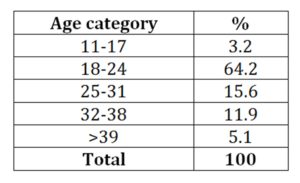
Occupation
In Table 2, the distribution of users’ occupation is given. The majority (67.4%) of the respondents are students, followed by 11.5% from business industry. The results show the involvement of students using library is undeniable due to fulfilling their education needs. Furthermore, it is good to acknowledge about 1% of the sample is unemployed who are still willing to spend their time in NLM. Apart from that, medical background users which constituted only 0.9% of the sample is expected they are non-regular users of NLM as they may find more relevant materials at their hospitals or specific library.
Table 2: Occupation distribution of library’s visitors
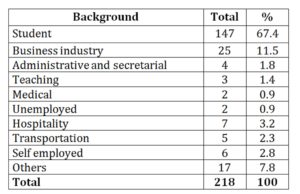
Total number of visits
Figure 2 exhibits the total number of visits to the library. The intention to capture the frequency is to acquire knowledge on how critical is the library in users’ life routines. It was found that the majority of visitors to NLM is between 4-6 visits per month, i.e. about 40%, followed by less than 4 visits (about 38%). About less than 21% paid their visits  10 times. In overall, the visitors may find the library as part of their needs due to the very low frequency detected per month i.e. less than 5 visits. However, there are some visitors who might consider NLM as an important place to fulfill their work/education/life needs, as they become regular visitors within a month.

Figure 2: The distribution of the number of visits to the National Library of Malaysia
Level of Education
Table 3 presents the education background of the respondents visiting the library. It was found that more than three quarters of the total sample are having higher degree background, which makes about 75%. The respondents could be still engaged with the higher learning institution or might have finished their studies. However, observing back the age distribution (in Table 1), it can be drawn that the majority of the visitors are students.
Table 3: Education level of NLM visitors

Types of Electronic Resources Used
Figure 3 depicts the types of electronic resources used by the respondents. The Majority is accessing the Internet (34%), followed by articles (16%). Visitors seem to have interest to access e-newspapers, about 14% of access captured in the findings.
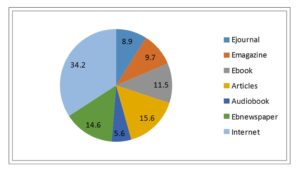
Figure 3: Types of electronic resources used
Individual Behavior (IB)
The average of mean score for Individual Behaviour (IB) variable is 3.41, indicates the inclination to positive agreement of the variable. The mean and standard deviation of each item in IB is as exhibited in Table 4. The results show that IB4 and IB5’s mean scores are among the highest, 3.47 and 3.56, respectively. IB4 relates to “I know how to evaluate electronic resources for my study” and IB5 refers to “I used the electronic resources to solve problems”. The dispersion of each item is small indicating low variability. These early findings suggest the respondents show their positive capabilities in assessing and knowledge of using electronic resources for their intention of use.
Table 4: Descriptive Statistics for Individual Behavior

Library Staff (LS)
The descriptive profile of this variable is as presented in Table 5 where the average mean score is 3.24. The lowest mean score is 3.18 for LB2 and LB3, relating to questions of “Library staff are very knowledgeable in electronic resources” and “Library staff are very courteous”, respectively. The highest mean score is 3.33, for question “Library
staffs are very helpful in accessing electronic resources”. Based on the finding, early conclusion signifies that respondents inclined to agree with the items describing the factor of library staff. Moreover, the standard deviation for all items in LS shows low variability indicating a strong agreement towards the respective mean scores obtained.
Table 5: Descriptive Statistics for Library Staff

Library Services (LS)
Table 4.12 provides the summary statistics for library services. The average mean score of LS is 3.34, where the highest is 3.62 (“Library provides conducive learning environment to support electronic resources”) and the lowest score is 3.18 (“Library has conduct adequate promotion and activities to encourage usage of electronic resources”). The finding provides an early indication that respondents are in positive agreement with the item describing the factor of LS.
Table 6: Descriptive Statistics for Library Services
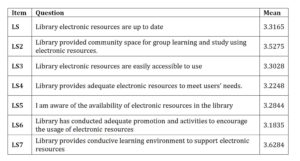
Library Technology (LT)
Library Technology (LT) variable shows the overall mean score of 3.35. The result of all items is as given in Table 7. The lowest mean score is 3.19 for LT6 (“Interface of electronic resources portal is friendly”) whilst the highest mean is 3.52 (“WIFI/Internet is accessible to me”). Again, the results attained are in favour of inclination towards positive agreement to the items as described in the questionnaire.
Table 7: Descriptive Statistics for Library Technology
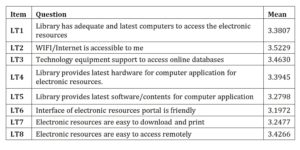
User satisfaction (US)
The variable of User satisfaction (US) shows an overall mean of 3.30, signifies a positive agreement towards the user satisfaction variable, as defined in the study. Table 8 displays the mean scores of all items under US factor. It is discovered that the lowest mean score is 3.21, meant for question of US2 (“I am satisfied with the convenience to use of the electronic resources”). The highest mean score (3.38) is relating to the question of “I am satisfied with library services providing electronic resources services to the users that can access remotely”. Again, low dispersion of the mean score is detected for US variable. As indicated by Razilan et.al (2009), user satisfaction is achieved by the usability of a system that fits to support the work practice/environment.
Table 8: Descriptive Statistics for User Satisfaction
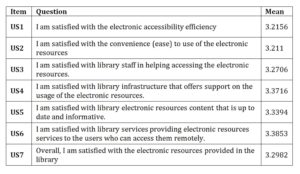
The following section provides the findings in relation to the analysis of relationships of the research variables.
Correlation Analysis
In this section, the relationship of the factors is observed through correlation analysis. The correlation approach provides the platform to investigate bivariate linear relationship of variables of interests. The Pearson product-moment correlation test is performed using SPSS where the results reveal the strength and magnitude of the relationships. The significance of the result indicates the statistical evidence of relationship in linear fashion.
The correlation analysis is performed to investigate the bivariate linear relationships between user satisfaction and study variables i.e. individual behavior, library staff, library services and library technology. All of the study variables possess a positive relationship with user satisfaction. Moreover, all are significant at 0.01 significance level. Full results can be referred to Table 9. It exhibits the results where, among the four study variables, the variable of library technology shows the highest positive relationship with user satisfaction, i.e. by having r=0.588. In spite of the fact that it is the highest value, the coefficient indicates only a moderate positive relationship. The weakest relationship is shown by individual behavior, with r=0.341.
Table 9: The Pearson product-moment correlation coefficients of all study variables against User Satisfaction
 Note: *p < 0.01
Note: *p < 0.01
The result is as shown in Table 9 where it serves as a preliminary finding in examining the relationship between user satisfaction in using electronic resources and selected factors. This initial study implies how crucial are the services and technology of a library in fulfilling users’ satisfaction.
Conclusion
A study on the relationship between factors of electronic resources usage and user satisfaction at the National Library of Malaysia is presented in this paper. NLM plays important roles to provide the collection of knowledge at the national level for present and next generations. Apart from that, NLM has to determine the high-demand of library resources from users to help the Malaysia’s people to be an informative and knowledgeable society. This study had revealed that Library Staff and Library Technology play crucial roles in influencing the usage of electronic resources at NLM. Due to this, NLM should play their vital role in positioning themselves to be at par (or more) with users’ expectation.
The study findings provide evidence of relationships between Individual Behaviour, Library Staff, Library Services and Library Technology. Although the moderate and weak relationships detected from the data, moving forward, NLM could establish priorities to align with users’ expectations and needs for the betterment of their services. Users’ experience is far more valuable to NLM to under the radar of users’ requirements, needs and interests.
Moreover, in order to promote and encourage users to visit the library, the librarians should be knowledgeable and supportive in guiding users to easily access information of their interest in particular for electronic resources. Information overload may be wasted or underused or can make users confused in choosing the right information. On the other hand, lack of information could lead to insufficiency of guidance. Library staff should play their role in assisting users with basic library information literacy on matters like how to search and retrieve the right information. The advance of technology provided by the library could attract users to come and use library services. Library, as well as librarian, needs to conduct regular and adequate promotion to ensure all the users recognize the availability of the digital services.
References
- Collison, R. L. (1952). ‘Information Services in Public Libraries,’ Aslib Proceedings, 4(4), 213-224.
- Kinengyere, A. A., George, W.K. and Bernard, B.B. (2012). ‘Factors affecting utilization of electronic health information resources in universities in Uganda,’ Annals of Library and Information Studies, 59(2) 90-96.
- Lee, S. D. and Boyle, F. (2004) Building an Electronic Resources Collection: A Practical Guide, 2nd edition, Library Association Publications, Facet, London.
- Mamtora, J. (2013) ‘Transforming library research services: Towards a collaborative partnership,’ Library Management, 34(4/5), 352-371.
Publisher – Google Scholar
- Mohd Nadzir, M., Abd Wahab, A. and Othman, N. (2015), ‘Undergraduates’ needs and seeking behaviour: A preliminary study,’ Proceeding of the 8th International Conference on Education and Information Management, 16-17 May 2015, Penang.
- Nadzir, M. M. and Salim, J. (2013). ‘Information seeking behavior factors: A Measurement Model,’ Proceeding of the Research and Innovation in Information Systems (ICRIIS), IEEE International Conference, 168-173.
- O’Brien, H.L. and Toms, E.G. (2010), ‘The Development and Evaluation of a Survey to Measure User Engagement,’ Journal of the American Society for Information Science and Technology, 61 (1). 50-69.
Publisher – Google Scholar
- Razilan, A.K., Dollah, W.A., Saaid, F.A. and Diljit, S. (2009), ‘A user-based measure in evaluating academic digital library,’ Proceeding of International Conference on Academic Libraries – Vision and Roles of the Future Academic Libraries, Delhi, India, 83-89.
- Shen, L. (2010), ‘Study on collaborative information seeking behavior for academic information in Web 2.0 environment,’ Proceeding of Information Engineering and Electronic Commerce (IEEC), 2nd International Symposium on IEEE, 1-4.
- Skretas, G. (2005) ‘Factors affecting the full use of library and information management systems by library personnel,’ Program: Electronic library and information systems, 39(2), 139-146.
Publisher – Google Scholar
- Steve, M. (1996) ‘Developing academic library skills for the future,’ Library Review, 45(5), 41-53.
Publisher – Google Scholar
- Tyler, K. and Hastings, N. B. (2011), ‘Factors Influencing Virtual Patron Satisfaction with Online Library Resources and Services,’ Journal of Educators Online, 8(2), n2.
- University of Michigan, (2015). Library Information Technology. Retrieved on 7th April 2016 at http://www.lib.umich.edu/library-information-technology.
- Wilson, T. D. (2000) ‘Human information behavior,’ Informing Science, 3(2), 49-56.
- Wu, M. Y., Chou, H. P., Weng, Y. C. and Huang, Y. H. (2008), ‘TAM-2 based study of website user behavior-using web 2.0 websites as an example,’ WSEAS Transactions on Business and Economics, 4(8), 133-151.














